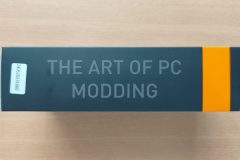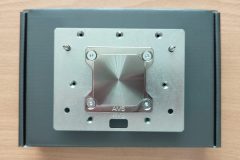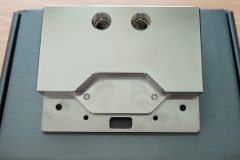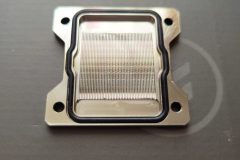The discussion around All-In-One (AIO) CPU coolers versus custom loops will always be ongoing. However, recently there has been a lot of innovation in the AIO market by manufacturers to try to match the performance and customizability of custom loops. Corsair, not to be outdone by its competitors, is launching its next-generation AIO CPU cooler, the iCUE LINK Titan RX RGB. The Titan combines Corsair's latest advancements in cooling engine technology, replaceable pump caps, and iCUE LINK RX120 fans in hopes of being your next CPU cooler.
In addition to the Titan AIO, Corsair supplied me with three of its CapSwap modules. This review will examine the iCUE LINK LCD Screen, VRM Fan, and Pump Cap Groove modules. Is the Titan good enough to topple another AIO I've recently reviewed, the Cooler Master 360 Ion? Continue reading to find out.

EKWB, also known as EK have been making water cooling components for the PC enthusiast for a good while now, 20 years as of the writing of this review. Their products have become well known and trusted among many globally. Today we are looking at their EK-Quantum Velocity² D-RGB Water block. It comes in both Intel and AMD flavours, but today we will be reviewing AMD SKU on an the AM5 platform. Read on to see what we find.
EK-Quantum Velocity² D-RGB Features
Before we delve into the review itself, lets take a look at the features of the Velocity² as touted by EK.
Socket Specific Cooling Engine
Embedded in the Velocity² is a socket-specific low hydraulic flow restriction and high-performance cooling engine, which is achieved by a combination of mounting pressure and cold plate geometry tailored for the IHS and die layout of the AMD AM5 socket. The lathe-turned cold plate is made with precision to cover the IHS effectively and put optimal pressure on the die area. Flow is also being directed into areas that need it most with the help of an asymmetric jet plate cutout. The Velocity² series water blocks cover the entirety of the socket while conforming to socket guidelines about mounting pressure and socket keep-out zones.EK-ExactMount
Because of the integrated, sturdy stock backplate arriving with AM5 motherboards, the patent-pending EK-ExactMount mounting system was re-engineered for an even simpler installation process. The end result is an even easier-to-use and “invisible” mounting mechanism since the entire mounting system is inside the water block, and now it is a true single-piece product. The backplate is factory-mounted on the motherboard, and the spring-loaded Torx screws are integrated into the water block and are screwed by counter-clockwise rotation into the stock backplate of the motherboard.The integrated mounting screws are engineered with a hard-stop design, so once screws reach the end of the thread, the block is perfectly mounted and tensioned. This removes the risks of over-torquing the water block and potentially damaging your motherboard and/or CPU.
Water Block Material and Manufacturing
The coldplate is manufactured out of the highest-grade 99.99% pure electrolytic copper, machined with precision for the best possible contact and heat transfer which is further nickel-plated. This version of the water block features a nickel-plated cold plate with a CNC-machined nickel-plated brass top.EK-Matrix7 Compliant
The EK-Quantum Velocity² is an EK-Matrix7 compatible product. The EK-Matrix7 is a product raster that is bound to set a new standard. EK is adding a new dimension to PC liquid cooling, where the height of products and the distance between ports are managed by increments of 7mm. This improves product alignment and reduces the time spent planning the loop and bending tubes. Through the meticulous planning of our products, building a liquid-cooled PC becomes easy and fun, just like toy bricks.EK-Quantum Velocity² D-RGB LED Lighting
This product is compatible with all popular addressable RGB sync technologies from all major motherboard manufacturers. The arrow marking on the 3-pin D-RGB LED connector is to be aligned with the +5V marking on the D-RGB header. A total of 17 addressable RGB LEDs are hidden under the stick-out piece, which acts as a diffuser.
Specifications
The technical specification due to the nature of the product is short and sweet:
Technical specifications:
– D-RGB cable length: 50cm
– D-RGB connector: 3-pin 5V digital LED header (Pinout: +5V | Digital | Blocked | Ground)
– Dimensions: (LxHxW) – 89×113,5x34mm
You can find full dimension data, additional specifications and installation process of the block in the below manual download.
Packaging & Unboxing
As per tradition with EK, we see the EK-Quantum Velocity² D-RGB Water block housed in packaging with the classic black and orange colouring motif. The packaging is understated but striking. Sometimes less is more! To the rear of the package we see product description alongside what we expect to find inside. To the side we see the “The Art Of Modding” slogan which I think has a nice ring to it.
With the removal of the outer sleave we are presented with the inner box. Immediately upon opening the box you are presented with an exceptionally shiny water block. This was shinier than expected considering this is the Satin Nickel finish and not polished.
Once the block is removed you will be met with the included accessory kit which includes:
- Thermal Grizzly Hydronaut (1g)
- 2x Allen keys (which would allow for the disassembly of the water block)
- 1x Torx T7 Key (Used for the installation of the block to motherboard)
- Spare Mounting Screw.
I was pleased to see the inclusion of a high quality thermal paste, after all it is EK’s best interest that they provide everything to the consumer for the best possible experience. So a brownie point to EK for that move. That being said, for this review I will be using my preferred thermal compound, Thermal Grizzly Kryonaut Extreme. My point of view is that once that water block is on the CPU, it is staying there for a while, so I tend to always go the top end of the thermal compound products to give the thermal transfer the best chance possible. Obviously you could go for for Thermal Grizzly Conductonaut, BUT that is a liquid metal compound and comes with devastating risks if you get it on the motherboard or other electrical component as it will cause a short. I prefer not to risk it.
Quick Look
Immediately upon taking the block out of the packaging, it is no doubt chunky & heavy, but what do you expect from a solid lump of plated copper. Looking top down we can see the block is divided into two sections. Once side houses the G 1/4″ ports, while the other side is a plastic component that features the EK logo along with the product name (Velocity²). The plastic side also houses all of the RGB components.
On the reverse we see the block with 4x integrated mounting screws which will locate into your motherboard backplate upon installation. We also see the block fixings as well as the RGB connector. As with all good products, the cold plate is protected by a sticker, which of course PLEASE remove before you install.
After the removal of the cold plate protective sticker we can now see the cold plate in all its shiny glory. I was very happy with the finish and you can only see very subtle CNC machining marks, which is to be expected and would be negated once you use the included thermal paste or one of your choice.
Disassembly
I felt that as part of the review process, I needed to take a look inside the block to look at its make up and see how it ticks. I will not go into every detail of the make up of the block, the images below are in order of disassembly.
All in all the machining quality and precision is top notch. Which can also be said for the sealing O-Rings used. The only minor negative finding was that the cooling fins in the cold plate, there were a couple of areas of potential blockage towards the end of the fin stack, you can see this in the last image above. This is highly likely to be something that occurred during the Nickel plating and not the machining. It is unlikely this is something you would find across all samples of this product. One saving grace is that the issue is easily rectified by using a small implement to break away the piece of plating causing the blockage. That being said, I was comfortable doing this and I am not recommending it to all.
Performance Testing
We will be conducting the OCCT CPU default benchmarks and a 10 minute run of Cinebench R23 to get the CPU nice and toasty to put the block through its paces.
Relevant Test System Specs
CPU – AMD Ryzen 9 7950X3D (16c/32t)
Motherboard – MSI Meg ACE X670E
GPU – EVGA 3090 FTW 3
WC Loop Setup
CPU Block – EK-Quantum Velocity²
GPU Block – EK Vector FTW 3
Radiator 1 – Black Ice Nemesis 420 GTR
Radiator 2 – Black Ice Nemesis 240 GTS
Radiator Fans – Noctua NF-A14 industrialPPC
Reservoir – Aqua Computer ULTITUBE D5 NEXT 200 PRO RGB Pump / Reservoir Combo
Coolant – Mayhem Clear X1
Thermal Compound – Thermal Grizzly Kryonaut Extreme
Testing Conditions
- Ambient temps at time of testing – 27.7 (Summer time)
- It is to be noted that while the WC loop includes a GPU, the GPU is not under any load during these tests.
- CPU is running at stock values and maximum potential clocks are achieved via PBO2
- Pump Speed – 60%
- Radiator Fans Speed – 50%
- OCCT Benchmark – All default settings
- Cinebench R23 – All default settings
OCCT Results
Max temperature: 69.13c
Max average temperature: 57.31c
Cinebench R23 Results
Max temperature: 85.9cMax average temperature: 79.7c
It is clear via the testing that Cinebench R23 puts a far heavier load on the CPU than OCCT. The temperatures during the Cinebench test are to be expected when considering the load and the CPU in question. During the Cinebench test we were pulling an average of 128.1 Watts with a maximum of 151.7 Watts. This is much more than OCCT with 97.7/106.6 Watts respectively.
The RGB
If you recall, I mentioned an RGB element to this block. It would be remiss of me to not show the block in its lit up RGB goodness.
ConclusionOverall I am very happy with the EK-Quantum Velocity² D-RGB Water block. It comes with an entire installation kit allowing for an easy install, the fact that it comes with thermal compound included, there is virtually no excuse to not get it mounted into your system on day one of receiving it, unless you don’t have your motherboard or CPU yet of course. With the EK-ExactMount feature the block comes in a singular piece, as such there is ZERO preliminary work required to get the block ready. Of course this is only possible due to the AM5 motherboard backplates being extremely sturdy, so EK cannot take all the credit, but they certainly get all the credit for taking advantage of this fact.
The workmanship & construction of the block is excellent as per the “Disassembly” section, the only small niggle was the Nickel plating blocking the end of a couple of the fin channels in the cold plate but this was easily rectified from my end. I cannot speak as to how this would have effected performance if the erroneous piece of Nickel plating had not been removed but I highly doubt it would result in sub par performance. Ultimately most people are not opening up the blocks when they receive them, so your performance from day one (even if there was a minor blockage) would very unlikely indicate an issue.
HOWEVER, looking at this from a consumer point of view who will be expecting a near flawless product, I could see how this would come as a concern, after all you are spending good money on something and have high expectations. I cannot speak to EK’s QA process but it is possible they need to keep a closer eye on the fin array in the cold plate to ensure all channels are 100% clear before final assembly.
The RGB is, well RGB. There is not much to say about it other than I personally like the way the design is implemented and it is effective, but I would have been just as happy without it, but that is my own personal preference.
The overall aesthetic of the block is extremely pleasing, it is sleek and un-complicated. The combination of the plastic element (where the RGB is housed) with the metal element is seamless. There are no horrid join lines. EK have focused very heavily on tolerances regarding the aesthetics as they have throughout the design of the block. The block comes in varying finishes but the finish of the brushed Nickel is flawless! Very happy to have it shown off in my system.
The performance of the block through the benchmarking I found to be impressive and I have absolutely no concerns here. Of course your mileage may vary depending on your loop setup and whether or not you have other components contributing heat to the loop. Even though I have my GPU in the loop under zero stress, it still adds heat to the loop. It is possible that if the GPU was not in the loop, my CPU temps may have been even further improved. As it stands though I was very happy with the performance of the EK-Quantum Velocity² in my loop configuration. Taking everything into consideration I would give this product a “Recommended”. If it was not for the fin array issue, I would have happily have given this a “Must Have”.
| Pro's | Con's |
|---|---|
| Comprehensive Installation Kit | Erroneous Nickel Plating Could Cause Blockage |
| Block Comes As Singular Piece | |
| Easy Installation | |
| Overall High Quality Workmanship | |
| Excellent Aesthetic & Finish |
 Want to discuss this product or give your views and feedback from your own usage? Leave your comments and discuss HERE, on the ExtremeHW Forums (No Sign Up Required)
Want to discuss this product or give your views and feedback from your own usage? Leave your comments and discuss HERE, on the ExtremeHW Forums (No Sign Up Required)
Like our content? Please consider Donating to help us to continue our writing.

























